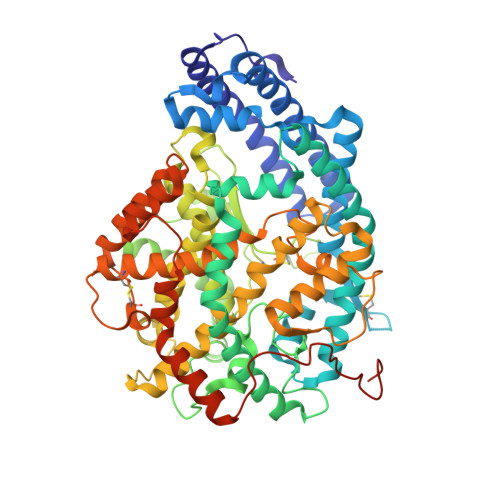Fragment-Based Design for the Development of N-Domain Selective Angiotensin-1 Converting Enzyme Inhibitors
Douglas, R.G., Sharma, R.K., Masuyer, G., Lubbe, L., Zamora, I., Acharya, K.R., Chibale, K., Sturrock, E.D.(2014) Clin Sci (Lond) 126: 305
- PubMed: 24015848
- DOI: https://doi.org/10.1042/CS20130403
- Primary Citation of Related Structures:
4BXK - PubMed Abstract:
ACE (angiotensin-1-converting enzyme) is a zinc metallopeptidase that plays a prominent role in blood pressure regulation and electrolyte homeostasis. ACE consists of two homologous domains that despite similarities of sequence and topology display differences in substrate processing and inhibitor binding. The design of inhibitors that selectively inhibit the N-domain (N-selective) could be useful in treating conditions of tissue injury and fibrosis due to build-up of N-domain-specific substrate Ac-SDKP (N-acetyl-Ser-Asp-Lys-Pro). Using a receptor-based SHOP (scaffold hopping) approach with N-selective inhibitor RXP407, a shortlist of scaffolds that consisted of modified RXP407 backbones with novel chemotypes was generated. These scaffolds were selected on the basis of enhanced predicted interaction energies with N-domain residues that differed from their C-domain counterparts. One scaffold was synthesized and inhibitory binding tested using a fluorogenic ACE assay. A molecule incorporating a tetrazole moiety in the P2 position (compound 33RE) displayed potent inhibition (K(i)=11.21±0.74 nM) and was 927-fold more selective for the N-domain than the C-domain. A crystal structure of compound 33RE in complex with the N-domain revealed its mode of binding through aromatic stacking with His388 and a direct hydrogen bond with the hydroxy group of the N-domain specific Tyr369. This work further elucidates the molecular basis for N-domain-selective inhibition and assists in the design of novel N-selective ACE inhibitors that could be employed in treatment of fibrosis disorders.
Organizational Affiliation:
*Institute of Infectious Disease and Molecular Medicine, and Division of Medical Biochemistry, University of Cape Town, Observatory, Cape Town 7935, South Africa.

























